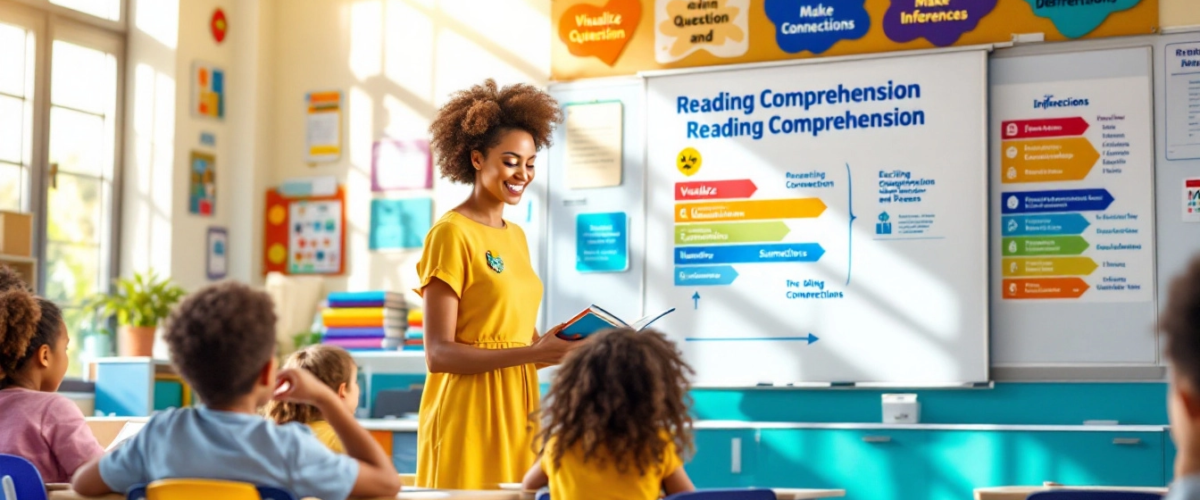Did you know that strong reading comprehension skills are the foundation of academic success and lifelong learning? From decoding texts to building critical thinking abilities, reading comprehension plays a pivotal role in personal and intellectual growth. Teachers, parents, and educators alike often seek effective methods for teaching reading comprehension to students of all ages, ensuring lessons that are both engaging and impactful. In this article, we’ll explore proven strategies, detailed reading comprehension lesson plans, and engaging, interactive reading activities to equip you with everything you need to foster thriving readers in your classroom or at home.
Table of Contents
- The Importance of Reading Comprehension in Education
- Proven Methods for Teaching Reading Comprehension
- Designing Effective Reading Comprehension Lesson Plans
- Interactive Reading Activities That Boost Engagement
- Common Challenges in Teaching Reading Strategies and How to Overcome Them
- FAQs
- Conclusion
The Importance of Reading Comprehension in Education
Why Reading Comprehension Matters
Reading comprehension is a cornerstone of learning. It allows students to engage with texts beyond surface-level reading, enabling a deeper understanding of concepts and ideas. Strong comprehension skills lead to enhanced academic performance across all subjects, as students apply these abilities to analyze information, synthesize data, and think critically. Furthermore, these skills are fundamental in real-world problem-solving and decision-making tasks, setting learners up for long-term success.
Developing these skills in early education is particularly crucial. As children grasp the basics of literacy, they also learn how to interpret and apply information effectively, paving the way for lifelong learning. Learn why early literacy matters. External research, such as studies highlighted by National Literacy Study, further supports the importance of integrating strong pedagogical approaches to reading comprehension.
Understanding the Barriers
Many students face challenges with reading comprehension due to diverse barriers. Common factors include limited vocabulary, struggles with fluency, or a lack of prior knowledge related to the text. Socioeconomic challenges, such as limited access to books and educational resources, also play a role. Identifying and addressing these barriers is the first step toward developing effective teaching strategies that benefit all students.
Proven Methods for Teaching Reading Comprehension
The Role of Scaffolding in Reading Instruction
Scaffolding is an essential teaching technique that gradually transitions responsibility from the educator to the student. Following the “I do, we do, you do” model, this approach supports learners as they develop confidence in independent comprehension. Pairing beginner readers with advanced peers is another useful strategy within this framework, promoting skill-sharing and collaborative learning. Explore differentiated instruction techniques to enhance your scaffolded lessons further.
Incorporating Discussion-Based Activities
Encouraging group discussions around reading materials not only boosts engagement but also deepens comprehension. Methods like Socratic questioning challenge students to think critically about themes, characters, and plots, fostering a richer understanding. By sharing ideas, learners develop new perspectives, expanding their comprehension of the text and improving their communication skills.
Using Technology to Enhance Comprehension
Technology provides innovative ways to enhance reading comprehension. Educational apps, eBooks, and gamified platforms such as Raz-Kids and Epic! create interactive experiences that adapt to a student’s level and provide instant feedback. According to research into technology in education, digital tools are particularly effective at improving both engagement and outcomes in reading comprehension.
Designing Effective Reading Comprehension Lesson Plans
Structuring Lessons for Maximum Impact
An effective lesson plan for reading comprehension is built on three stages—pre-reading, during-reading, and post-reading activities:
- Pre-reading: Engage students by activating prior knowledge, setting specific goals, or predicting content using the title and images.
- During-reading: Encourage annotating, questioning, and identifying key ideas as they read.
- Post-reading: Incorporate summarization, reflective discussions, or creative tasks to reinforce understanding.
These steps provide a clear structure, ensuring students approach texts with purpose and remain engaged throughout.
Adapting Lesson Plans for Diverse Learners
Effective lesson plans accommodate the diverse needs of learners. For students with disabilities, modifications such as larger fonts, audiobooks, or visual aids enhance accessibility. Multilingual classrooms can benefit from scaffolded instruction that integrates both the students’ native languages and their target language to strengthen comprehension. Learn more about designing lesson plans for diverse classrooms.
Interactive Reading Activities That Boost Engagement
Fun and Innovative Activities for the Classroom
Interactive activities can make reading comprehension fun and engaging. Role-playing based on storylines immerses students in the text, while collaborative storytelling encourages creativity and teamwork. Setting up escape-room challenges linked to key plot points or themes is another exciting approach to fostering engagement.
Leveraging Hands-On Experiences
Hands-on projects such as book-making allow students to combine comprehension and creativity. Additionally, using real-world texts like menus, maps, and instructions helps students connect reading skills with practical, everyday applications.
Common Challenges in Teaching Reading Strategies and How to Overcome Them
Addressing Differentiated Learning Needs
Balancing the needs of advanced and struggling readers in the same classroom requires thoughtful strategies. Diagnostic assessments help identify individual strengths and weaknesses, enabling tailored support. Small group instruction or tiered activities ensure that every learner can progress at their own pace. Discover student assessment strategies in-depth.
Overcoming Lack of Motivation
Reluctant readers often need a personalized approach to spark interest. Empowering students through choice—whether selecting their reading materials or engaging in self-paced tasks—boosts ownership and motivation, creating a more positive learning environment.
Frequently Asked Questions
What are some effective methods for teaching reading comprehension in early grades?
Simple strategies like read-alouds, graphic organizers, and repetition help younger learners develop foundational reading comprehension skills.
How can I create interactive reading activities for older students?
Technology-based tools, group challenges, and real-world text analysis are excellent ways to engage older readers actively.
What are the essential elements of a strong reading comprehension lesson plan?
A strong lesson plan includes pre-reading goals, interactive in-reading activities, and post-reading activities focused on reflection and summarization.
Why is scaffolding important in teaching reading comprehension?
Scaffolding gradually builds students’ confidence, offering guided support at first and encouraging independent comprehension over time.
What are some ways to address the needs of multilingual classrooms?
Incorporating bilingual materials and scaffolded strategies helps multilingual learners build skills in both their native and target languages.
Conclusion
Effective methods for teaching reading comprehension combine structured lesson plans, engaging activities, and thoughtful strategies that address diverse learner needs. By applying these proven techniques, educators can foster not only academic success but also a lifelong love of reading in their students. Begin small, experiment with creative approaches, and watch as your students’ enthusiasm for reading flourishes. Ready to transform your teaching approach? Start implementing these ideas today!




